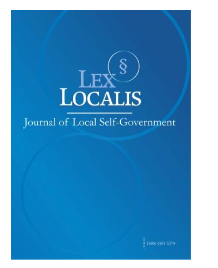GREEN FINANCING OPTIONS, EXPLORING GRANTS AND SUBSIDIES FOR SUSTAINABLE STARTUPS, ACCESSING GREEN LOANS AND GRANTSgreen startups with appropriate funding sources, thereby streamlining the connection between innovative ideas and capital.
DOI:
https://doi.org/10.52152/801377Ključne besede:
Green Financing, Sustainable Startups, Grants and Subsidies, Green Loans, Eco-Innovation, Environmental Funding, Clean Technology, Impact Investing, ESG Standards, Renewable Energy, Sustainable Development, Green Investment, Financial Incentives, Climate Finance, Green Economy.Povzetek
In a time of growing environmental issues and climate change, the drive toward sustainability is more important than ever. Startups and small businesses are expected to be more instrumental in forming a sustainable future as world economies move toward greener paradigms. For many of these businesses, though, the financial load related to sustainable infrastructure, eco-innovation, and clean technology still be a major obstacle. For sustainable businesses trying to bring environmentally friendly ideas to market without sacrificing financial viability, green financing options including grants, subsidies, and green loans provide essential lifelines. Emphasizing the need of access to specific funding resources that support environmentally friendly practices, this abstract investigates the several green financing options open to startups. Examining both public and private sector projects emphasizes how green finance closes the innovation gap with implementation, especially for early-stage businesses trying to scale their green solutions. Grants and subsidies represent among the most well-known sources of green money. Usually governments, international organizations, and environmental NGOs supply these financial support to inspire creativity in fields including waste management, green manufacturing, sustainable agriculture, and renewable energy. Grants are a great choice for startups with limited cash flow since they unlike loans do not demand repayment. Many environmental grantinitiatives to support clean tech development have been started in areas including the European Union, North America, and portions of Asia. As part of the EU's larger goal to reach net-zero emissions by 2050, the European Green Deal, for instance, provides billions in support to sustainable businesses. To lower the initial costs of green investments, numerous local and national governments also provide direct subsidies and tax breaks. These could include financing for research and development of low-carbon technologies, subsidies for fleets of electric vehicles, or rebates for solar panel installations. In addition to fostering the growth of green startups, these policies hasten the market uptake of sustainable goods and services. Green loans have become a powerful instrument for sustainable finance in addition to grants. These are loans specifically designated for environmentally beneficial projects, and they frequently have favorable conditions like reduced interest rates, extended payback periods, or repayment plans that are based on performance. To assist with climate-resilient projects, organizations such as the World Bank, the Green Climate Fund, and several green investment banks provide specialized green loan programs. In order to specifically serve small and medium-sized businesses (SMEs) with environmental missions, some commercial banks have also entered this market by introducing green loan portfolios. Accessing green loans or grants for startups in need of these funds necessitates both a strong business plan and an unambiguous proof of environmental impact. The majority of funding organizations assess applications using standards like energy efficiency, circularity, social sustainability, and carbon footprint reduction. Thus, it is essential to have solid environmental metrics and data to support assertions. Furthermore, obtaining certifications such as B-Corp status or compliance with ESG (Environmental, Social, and Governance) standards can boost one's credibility and chances of getting funding. Additionally, startups now have more opportunities to interact with mission-driven investors who value sustainability in addition to financial returns thanks to the growth of impact investing. Green-minded venture capital firms and angel investors frequently offer seed money to eco-innovative companies, seeking high-growth prospects in line with long-term environmental objectives. Additionally, by reaching out to eco-aware communities, crowdfunding websites such as Kickstarter and Indiegogo are being used to fund green startups. Notwithstanding these encouraging advancements, obstacles still exist. Many startups are not equipped with the knowledge, skills, or resources necessary to successfully negotiate the intricate world of green finance. Grant and loan application procedures may be extremely competitive and cumbersome. Additionally, global scalability is hampered by the uneven distribution of green funding across various regions. Governments, financial institutions, and the private sector must work together more closely to close these gaps in addition to implementing policy changes and raising entrepreneur financial literacy. To address these challenges, startup incubators, accelerators, and advisory organizations are increasingly offering green finance consulting services, helping early-stage companies identify suitable funding options, prepare compelling applications, and build investor-ready sustainability strategies. Digital tools and platforms are also emerging to match green startups with appropriate funding sources, thereby streamlining the connection between innovative ideas and capital. In conclusion, green financing is not merely a niche category of economic support; it is an essential enabler of the global transition toward a more sustainable economy. By making green finance more accessible, equitable, and aligned with the realities of early-stage startups, stakeholders can unlock a wave of innovation that tackles some of the world’ s most pressing environmental issues. Whether through grants, subsidies, green loans, or impact investing, the opportunities for sustainable entrepreneurship have never been more abundant, but seizing them requires a well-informed, strategic, and purpose-driven approach.
Prenosi
Objavljeno
2025-08-25
Številka
Rubrika
Article
Licenca
Avtorske pravice (c) 2025 Lex localis - Journal of Local Self-Government

To delo je licencirano pod Creative Commons Priznanje avtorstva-Nekomercialno-Brez predelav 4.0 mednarodno licenco.
Kako citirati
GREEN FINANCING OPTIONS, EXPLORING GRANTS AND SUBSIDIES FOR SUSTAINABLE STARTUPS, ACCESSING GREEN LOANS AND GRANTSgreen startups with appropriate funding sources, thereby streamlining the connection between innovative ideas and capital. (2025). Lex Localis - Journal of Local Self-Government, 23(S4), 4265-4291. https://doi.org/10.52152/801377








